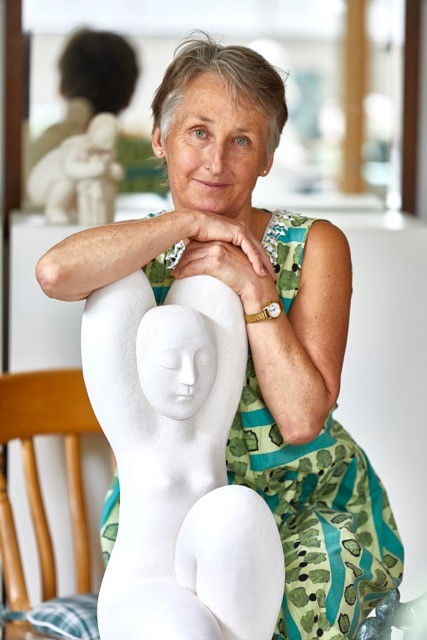
Sculptor Vanessa Pooley in her studio with one of her art works.
Achieving some decent publicity for your art exhibition or event is often the biggest challenge that artists and creatives face. When your key skill and focus is making art and setting up an exhibition, doing the PR and promotion can be last on your list. Here are a 10 tips to make it easier…
- Start as early as possible. Glossy magazines plan their editorial around five months ahead, so if your exhibition is in June, you’ll want to be sending out your releases in the January before. Ideally, start planning the publicity around eight or nine months before the launch date. Local arts magazines such as ArtsEast, a popular publication where I’m based in Norwich, work around three months ahead. Then, finally send your release to the local paper around two weeks before the launch. The more time you have the better results you are likely to achieve with your publicity.
- Think about possible target publications at the start of your PR campaign. Collect as many print publications as you can, especially local and hyperlocal ones, such as Triangle magazine, in Norwich. Work out their deadlines and send a friendly email to the editor asking for more information about what their ‘lead times’ or deadlines are for press releases. Next, compile a list of websites and social media that might be interested in covering your event.
- Set up social media. Pick a couple of social media sites that you are comfortable with, such as Instagram or Facebook and stick to those. It’s impossible to cover everything if you’re doing this yourself, so just focus fully on the ones you understand and know how to use. If it’s Facebook, set up a facebook event and links to your event website, for example.
- Don’t forget ‘what’s on’ sites – both in print and online. Send information to these, for example @enjoynorwich is a great site that let’s people know what’s happening in the City and is usually willing to give an event a plug if they think it merits it.
- Think pictures. Make sure you have some good images of your work and yourself. Have these in both high resolution versions (MB) and low resolutions (KB). Send the low resolution versions to editors first so you don’t gum up their inbox. However, let them know you have high resolution version (higher quality) of any they would like to use. Make sure you have a portrait of yourself the artist, or just a head and shoulders. Hold, or stand near, some of your work. Ideally, hire a professional photographer but if you can’t afford this a good iphone pic will suffice. Make sure the background is clean, move any clutter and stand in good light with the window over the shoulder of the person taking the photograph.
- Write a press release. Make sure it has all the correct information about opening hours, launch date, artist background and who to contact if a journalist or editor wants more information. Make sure the contact is somebody who is happy to answer their phone out of hours. Look for a good angle for your press release – is it your anniversary exhibition or something unusual for example.
- Write artist biographies for everybody taking part in the exhibition. One or two printed pages with the story of how they became an artist, their inspiration, their education and training, previous exhibitions, etc.
- Put together a content package of pictures of art work, pictures of artist, press release, artists biography to send to editors.
- Angle the release to fit the publication. If it’s a Norwich publication make sure you mention high in the release that the event is in Norwich. If it’s a publication for older people, make sure you mention in the first paragraph or so that the artist is older, for example.
- Send by email to relevant editors and follow up if you don’t hear anything – but don’t hassle them as they are busy people and it’s their decision ultimately about whether they will publish your story or not. All you can do is make your release and image as interesting as possible to optimise your chance of getting some good publicity.
Case study

Photographer Julia Cameron with her camera.
One of my clients is the leading British sculptor Vanessa Pooley. She was taking part in an exhibition in collaboration with two other artists Julia Cameron, a photographer, and Mary Mellor, a painter. We sat down early on and had a huge brainstorming session to see what we could find in common between the three. After much debate it emerged that they shared an obsession and passion for a particular subject that they had reworked and honed over decades. Vanessa was obsessed with the female figure, Julia with a particular segment of land near Great Yarmouth which she had repeatedly photographed and Mary with the Golden Ratio theory. So we had our common theme which led to a title for the exhibition and a press release. More research discovered that there was a zeitgeist towards favouring older women artists. We found an article in The Times setting out this theory and realised that it totally chimed with this exhibition in Norwich. I then helped come up with a title and put together a content package which was then disseminated over several months to relevant media, achieving some great coverage – such as this piece in the Eastern Daily Press.

